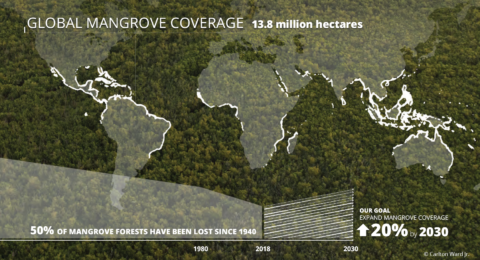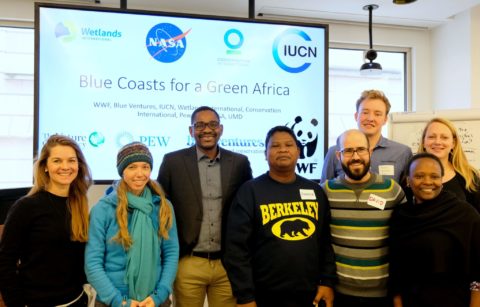
Global action to save mangroves: the Global Mangrove Alliance
-
Aquaculture, fisheries and coastal agriculture
-
Coastal resilience
-
Coastal wetland conservation
In January 2019, mangrove specialists of the Global Mangrove Alliance from all over the world came together to discuss approaches to save the world’s mangroves. Wetlands International was represented involving colleagues from the Philippines, Indonesia, Kenya, Senegal, Panama, and the Global Office. In this blog, I will share my personal experiences and the most important outcomes of the meeting.
What is the Global mangrove alliance?
Mangroves occur along tropical coastlines and are considered one of the most important ecosystems for nature and people. They are havens for biodiversity, provide rich fisheries resources and protect communities against storms and erosion. They also regulate our climate by sequestering and storing large amounts of carbon. However, worldwide mangroves are under threat from large scale infrastructure development and expansion of agriculture and aquaculture. As more and more people live along our coasts these pressures increase rapidly. To save our mangroves for future generations, it is crucial to work together.

That’s why Conservation International, IUCN, The Nature Conservancy, Wetlands International, and WWF came together in 2017 to form the Global Mangrove Alliance (GMA). By organising a global movement involving NGOs, private sectors and government partners we are working towards the bold target to increase global mangrove cover by 20% by 2030. By aligning our work and sharing lessons learned we have a stronger voice, we can scale up our interventions on the ground, and convince others to support mangrove conservation across the globe.
In the past year, we formalised the operational structure and overall vision of the alliance. The workshop marks a new phase in which we will work with our regional network to refine our strategy, develop plans for collaboration and hit the ground running!
The workshop – day 1: mapping opportunities for collaboration
We started off by mapping how we could work together in such a large alliance: What is needed for a smooth collaboration and what complementarities exist in approaches and experiences? While many of us had never worked together on projects, even though the organisations work in the same regions, it soon became clear that there is no lack of opportunities!
I met someone from The Nature Conservancy East Africa who is working in a mangrove delta South of the Rufiji Delta, where we work. We found out that our remote sensing technology could support communities and coastal zone managers in their project to better develop management plans for mangroves and other coastal ecosystems. Other partners were excited to learn from our experience in Indonesia on mangrove-based coastal defence. The other way around, we are very keen to tap into the experience of partner organisations on blue carbon and make use of the mangrove restoration potential map that was recently developed by The Nature Conservancy and IUCN.
But it is not just a matter of finding thematic synergies. We realised that getting to know each other personally, understanding our organisational differences and building mutual trust is at least equally important for a successful collaboration. As the focus of my day-to-day work is mostly on Africa, talking to people from other regions gave me a broader perspective and get to know the different organisations better.
The workshop – day 2: defining the most important mangrove issues
One thing I noticed is that broadly, most of us in the different regions are coping with similar issues. Coastal infrastructure development, large scale agriculture, aquaculture, overharvesting of natural resources – these are just some examples of threats to mangroves that are shared in different places of the world. We used the second day of the workshop to review our strategy and prioritise our future work. We split into groups and identified priority issues and solutions that we can focus on in order to meet our long-term goal.
Cooperation with communities
Sometimes there appear to be conflicts of interests between communities and conservation organisations. How to balance the need for communities to exploit mangrove resources while at the same time acknowledging the need for conservation. Realising that ultimately we strive for the same goal, to safeguard mangroves and their natural resources for future generations we asked ourselves the question: What can we do as an alliance to facilitate cooperation with communities, to engage together in the sustainable management of mangroves?
The different organisations of the alliance all have experience in these areas. We have all dealt with a variety of community groups and learned valuable lessons from these experiences. In Guinea-Bissau, for example, we established community-based protected forests and involved local community groups in the protection of the buffer zone of Cacheu national park. By reviving traditional natural resources management arrangements, we have enabled local community groups to become stewards of their natural environment (see our publication on the project in Guinea Bissau here). In other countries, we have experienced how local policies can either support local stewardship or be a driving force to local degradation.
These lessons we learned are often not shared outside our organisations. This is where the GMA could come in: by facilitating the sharing of lessons learned and by developing joint strategies for community engagement we optimally build upon each other’s experiences and maximise our impact.

Government buy-in
Many policies that seek to achieve economic growth, fail to take into account the values of mangroves. Large infrastructure and agricultural schemes, for example, may cause mangrove degradation and deforestation, causing loss of valuable fisheries resources and making coasts vulnerable to extreme events. To ensure that mangroves are conserved and restored, we need to make sure that government agencies at all levels recognise them for what they are worth: essential for nature and human wellbeing. Often their economic values are not recognised.
In our brainstorm, we considered what we can do to ensure mangrove conservation and restoration are mainstreamed into relevant policies. We explored bottom-up approaches where we help communities to put mangroves on the agenda. We also looked at top-down approaches for example by informing global and regional development strategies, by influencing procurement policies of financial institutions or by strengthening policies that promote more sustainable supply chains for mangrove commodities. Collaborating through a science committee the GMA will introduce key information on mangrove threats and values into policies thereby providing strong arguments to protecting our mangroves. We also agreed to develop a toolkit of model policies, which can easily be adapted to different contexts. On a regional level, we can use the alliance to align our messages. That will make our voice much stronger and unified, and make us a credible source. We have no lack of ideas on the thematic focus of our policy work: amongst others, we plan to promote mangrove-based climate change adaptation and mitigation strategies, introduce green infrastructure solutions as an alternative to conventional grey infrastructure solutions and will help governments to further improve their mangrove restoration strategies.
Good restoration practice
Recent studies in the Philippines and Sri Lanka show that less than 20% of restoration projects are successful. Governments and NGOs set area targets for restoration, often without any requirements in terms of the quality of the restoration. These ill-considered targets, combined with a lack of knowledge lead to failure of restoration. For example, many projects have been planting unsuitable species in unsuitable locations, in the wrong time of the year, and without making sure enabling conditions for mangrove recovery are in place.
In some of the projects of Wetlands International, we have been testing different methodologies of restoration. For example, in Guinea Bissau, together with local fishermen and farmers, we restored the hydrological functioning in abandoned rice fields, allowing mangroves to naturally regenerate. This method of restoration is not only much more effective, but it is also much cheaper as well. In many cases, planting is not even necessary to restore mangrove areas! Wetlands International wrote a paper on this together with colleagues from the Mangrove Action Project.
This kind of experiences should be shared broadly. During the meeting, we concluded one of our prime roles as the GMA, is to disseminate good restoration practice. We aim to do this by compiling lessons learned amongst organisation and by sharing guiding principles through training and our online knowledge hub.
The workshop – day 3: action plans!
After all the conceptual thinking, it was time to get concrete. The workshop group was split into regional teams who developed proposals for their respective geographies. For the Africa region, in which I was present, we developed a proposal focused on science and policy. We really tried to make use of our respective specialties, and to incorporate the insights we got through our problem- and solutions analysis. By specifying clear roles and responsibilities, we developed a strong proposal for a project in multiple African countries. Amongst others, we identified opportunities for using NASA’s remote sensing information as input to policy dialogues that are coordinated by IUCN. And we brainstormed how a work package on community-based mangrove management coordinated by Wetlands International could subsequently be connected to this policy work.
Hopefully, this marks the start of a much more comprehensive process towards developing shared regional mangrove strategies. It was very nice to see how the participants brought their first ideas together during this workshop session.
Summarising…
From the workshop it becomes clear that the GMA can be instrumental in building a global movement of mangrove professionals that share their experiences, align their messaging, team up in the field, collectively working towards an ambitious mangrove agenda.
Working groups on for example policy, science and communications along with regional teams will drive the work in the years to come. Make sure you closely follow the GMA website to hear more about our progress and stay posted on our progress.
Over the coming year, we plan to build up the alliance by inviting new partners, securing resources and getting ourselves organised. Until now, founding partners have used their own institutional resources to start up the alliance. Wetlands International would like to thank the National Postcode Lottery of the Netherlands for supporting this initiative. Their contribution has been essential for the establishment of the alliance.
Interested in becoming a partner? Learn more about joining the alliance.
